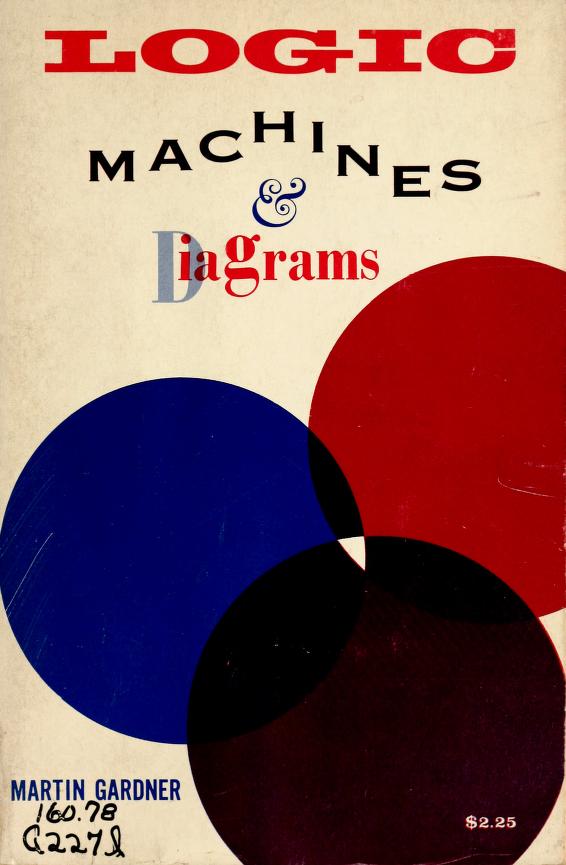Martin Gardner: Logic Machines and Diagrams (1958)
Filed under book | Tags: · diagram, logic, machine, mathematics, science

“A logic machine is a device, electrical or mechanical, designed specifically for solving problems in formal logic. A logic diagram is a geometrical method for doing the same thing. The two fields are closely intertwined, and this book is the first attempt in any language to trace their curious, fascinating histories. [..]
The reader may wonder why so much of the first chapter is devoted to the life and personality of Ramon Llull. The answer is that Ramon’s life is much more fascinating than his eccentric logic. Other logicians mentioned in the book may have been far from dull to those who knew them, but with the possible exception of Lord Stanhope, recorded details of their lives are comparatively drab and colorless. Llull’s Quixotic career is little known outside of Spain and France, and I make no apologies for introducing the reader to one of the most remarkable tragicomic figures of the Middle Ages.” (from the Introduction)
The book also covers logic diagrams and card methods for solving logical problems by Venn, Lambert, De Morgan, Peirce, Cunynghame, Lewis Carroll, and Gardner himself, and logic machines by Stanhope, Jevons, Marquand, and others.
Publisher McGraw-Hill, New York/Toronto/London, 1958
ix+157 pages
Review: W. Mays (Journal of Symbolic Logic).
PDF
Internet Archive (more formats)
Gilles Deleuze: Francis Bacon: The Logic of Sensation (1981–) [EN, ES, PT, HU]
Filed under book | Tags: · art, art criticism, body without organs, diagram, painting, philosophy

Gilles Deleuze was one of the most influential and revolutionary philosophers of the twentieth century. Francis Bacon: The Logic of Sensation is his long-awaited work on Bacon, widely regarded as one of the most radical painters of the twentieth century. The book presents a deep engagement with Bacon’s work and the nature of art. Deleuze analyzes the distinctive innovations that came to mark Bacon’s style: the isolation of the figure, the violation deformations of the flesh, the complex use of color, the method of chance, and the use of the triptych form. Along the way, Deleuze introduces a number of his own famous concepts, such as the ‘body without organs’ and the ‘diagram,’ and contrasts his own approach to painting with that of both the phenomenological and the art historical traditions. Deleuze links Bacon’s work to Cezanne’s notion of a ‘logic’ of sensation, which reaches its summit in color and the ‘coloring sensation.’ Investigating this logic, Deleuze explores Bacon’s crucial relation to past painters such as Velasquez, Cezanne, and Soutine, as well as Bacon’s rejection of expressionism and abstract painting. Long awaited in translation, Francis Bacon is destined to become a classic philosophical reflection on the nature of painting.
First published as Francis Bacon: Logique de la Sensation, Editions de la Difference, Editions du Seuil, France, 1981
Translated by Daniel W. Smith
Publisher Continuum International Publishing Group, London/New York, 2003
ISBN 0826466478, 9780826466471
228 pages
publisher (EN)
google books (EN)
Francis Bacon: The Logic of Sensation (English, trans. Daniel W. Smith, 2003)
Francis Bacon: Lógica de la sensación (Spanish, trans. Ernesto Hernández B. Revista “Sé cauto”, 1984)
Francis Bacon: Lógica Da Sensacão (Portuguese, trans. Silvio Ferraz and Annita Costa Malufe)
Francis Bacon: Az érzet logikája (Hungarian, undated, unpaginated, added on 2013-9-26)

